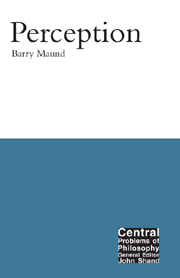Book contents
- Frontmatter
- Contents
- Preface
- 1 The philosophy of perception
- 2 A theory of natural realism
- 3 Theories of perceptual experiences
- 4 Representationalism: representations as natural signs
- 5 Natural realism: Putnam, Austin and Heidegger
- 6 Perception: the argument from illusion
- 7 The phenomenal and phenomenological senses of “looks”
- 8 Types of perceptual content
- 9 The representationalist–intentionalist thesis
- 10 Adverbialist accounts of perceptual experience
- Conclusion
- Notes
- References
- Index
2 - A theory of natural realism
- Frontmatter
- Contents
- Preface
- 1 The philosophy of perception
- 2 A theory of natural realism
- 3 Theories of perceptual experiences
- 4 Representationalism: representations as natural signs
- 5 Natural realism: Putnam, Austin and Heidegger
- 6 Perception: the argument from illusion
- 7 The phenomenal and phenomenological senses of “looks”
- 8 Types of perceptual content
- 9 The representationalist–intentionalist thesis
- 10 Adverbialist accounts of perceptual experience
- Conclusion
- Notes
- References
- Index
Summary
In Chapter 1 I argued for the importance of giving an account of what might be called the “natural view” of perception, even if only as the initial step in leading to a theory that revises that view. This natural view is often explained in terms of a description of what it is to perceive, from the first person point of view, that is, from the view of the perceiver. I argued that while this point of view is of great importance, considerations of the natural view need to be set within a wider context, one that takes into account both a third person and first person point of view. Such a context, I also argued, can be found in the Aristotelian–Stoic approach to perception.
For those within this tradition, perception is a process or activity whereby the perceiver comes to acquire knowledge of things in the world in which the perceiver is situated. Perception is characterized functionally: in a healthy organism, properly operating sense organs function so as to enable the organism to acquire knowledge of the world. Adopting this approach, it is possible to spell out the natural view of perception as a form of “natural realism”.
There are two sides to this view: an objective side and a subjective side. By adopting the third person point of view, we can describe the role and function of perception as a means by which someone navigates their way through their environment.
- Type
- Chapter
- Information
- Perception , pp. 25 - 50Publisher: Acumen PublishingPrint publication year: 2002

